Louis Wain: The Edwardian artist who was 'perhaps the best PR cats have ever had'
The artist's fascination with cats is the subject of a show at Chris Beetles Gallery which will feature 25 previously unseen works by Wain.


Picture this: the players hold their cards close to their chests. With money on the table, there is everything to play for. The player on the far right frowns at his hand. Has he been handed a miserable lot, or is this a bluff — his scowl of disappointment a decoy that conceals an ace? The player behind him, unseen, looks over his shoulder, his expression one of alarm as he inspects his rival's cards. The player next to him is also sneaking a peep, of a different player's cards, his face inscrutable. Another at the table is frozen in a gasp, the cause of which is unclear. Money hangs in the balance. One player has his hand to his brow, furrowed in concentration.
Or, should I say, has his paw to his brow — because these players are cats.
A Round Game of Cards is just one of the wonderful imaginings of Louis Wain — a brilliant artistic mind of the 18th century, and perhaps the best PR cats have ever had other than Chanel's Karl Lagerfeld.
From August 9-23 the annual Louis Wain & the Cat Show is returning to the Chris Beetles Gallery, in celebration of the 165th anniversary of his birth. Think cats playing tennis, a cat working a long shift as a ticket inspector and even a cat reenactment of Act III, Scene I of Shakespeare’s Julius Caesar, where Brutus attempts to appease the throng after Caesar's assassination with the immortal verse: ‘Meow meow meow meow meow meow, meow meow meow meow meow meow.’ (That’s cat for: ‘Not that I loved Caesar less, but that I loved Rome more.’)
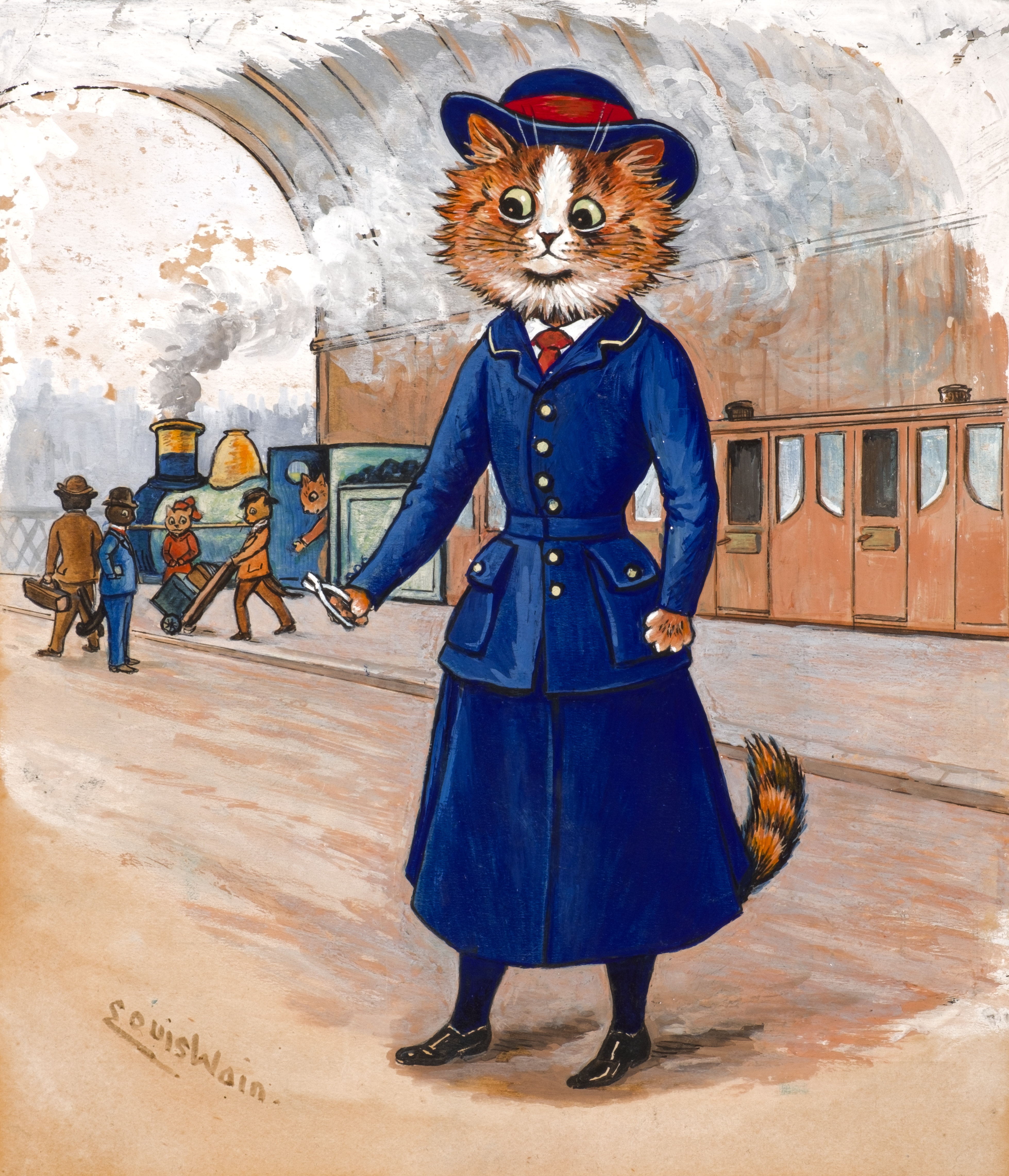
Louis Wain's 'Tickets Please!' is on sale with Chris Beetles Gallery for £8,500.
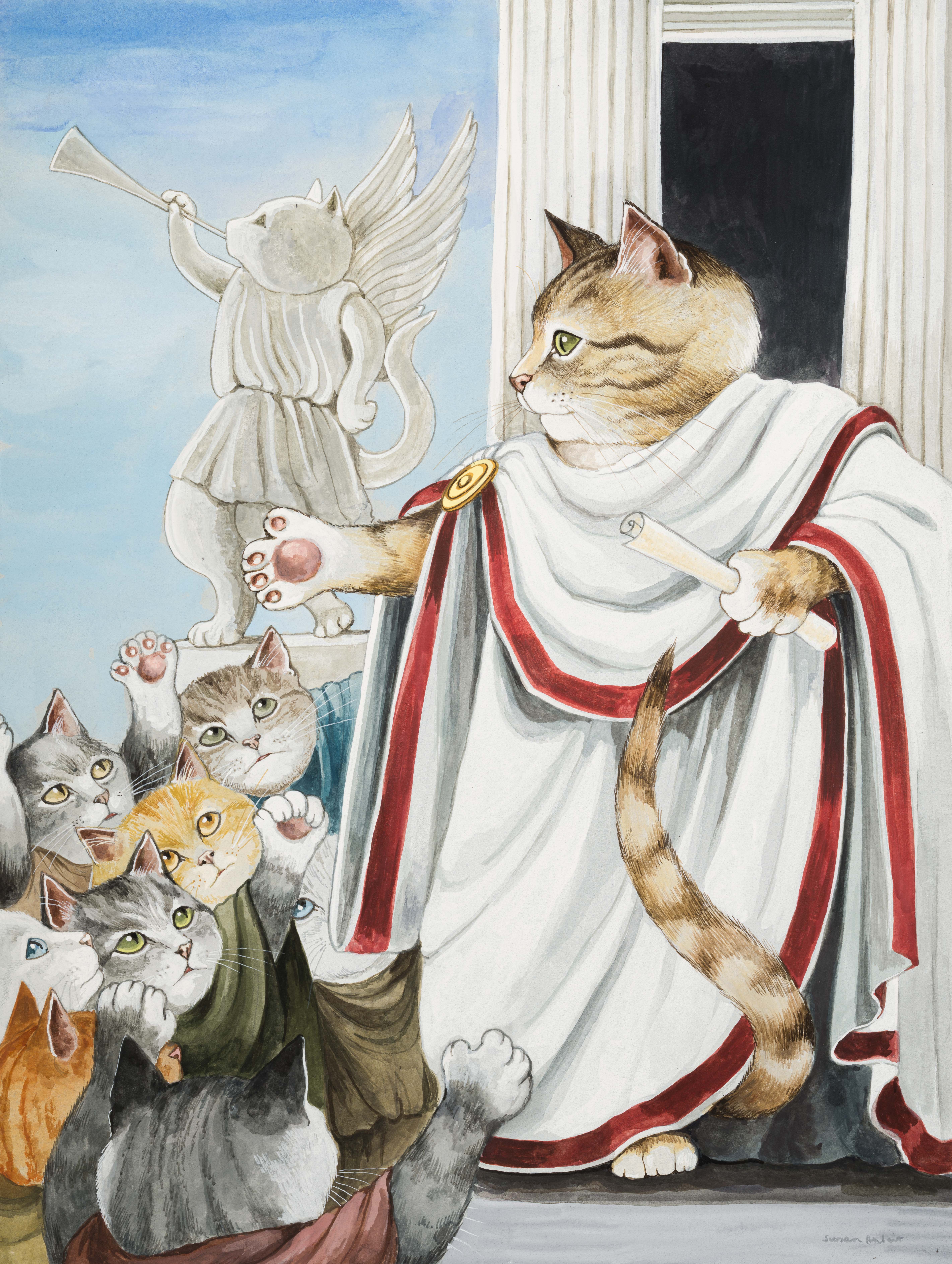
Other portraits of cats will also be part of the exhibition, including Susan Herbert's 'Julius Caesar, Act III, Scene II Shakespeare'.
Featuring in the exhibition will be 24 previously unseen works by Wain, whose depictions of cats were so popular they made him a celebrity. ‘He was a household name in the same way Quentin Blake is now. Everybody knew him,’ says Chris Beetles, the gallery’s owner, who used to have four cats of his own (their deaths, he said, ‘broke his heart’). Chris has put on the Cat Show at his gallery every year since 1980 and has written Wain’s biography, Louis Wain’s Cats. ‘It causes excitement every year,’ he says of the exhibition, ‘and it has only got more and more popular ever since the film came out’. The film he is referring to is The Electrical Life of Louis Wain, which came out in 2021 and stars Benedict Cumberbatch as the titular artist and Claire Foy as his wife, Emily Richardson-Wain.
And electrical Wain’s life certainly was. Born in Clerkenwell on August 5, 1860, to a textile trader and a church embroiderer, Wain was the eldest of six, the rest all girls. He had a cleft lip and was ill as a child, but eventually began attending school at the age of 10, though he often played truant.
A post shared by Chris Beetles Gallery (@chrisbeetlesgallery)
A photo posted by on

'Three Cats Singing' by Louis Wain is one of his more popular works.
The artist sold his first drawing in December 1881 (it appeared in the Christmas issue of the Illustrated Sporting and Dramatic News) and gave up his position as an assistant master at the West London School of Art a year after to pursue illustrating full-time.
Exquisite houses, the beauty of Nature, and how to get the most from your life, straight to your inbox.
In 1884 he married Emily Richardson in Hampstead, causing controversy as she had been the governess of his sisters, and was 10 years his senior. They welcomed into their small family Peter, a black and white kitten, who became an inspiration for Wain and Richardson’s comfort in times of ill health. His career flourished and his cats turned from being naturalistic to anthropomorphised, going about the business of the average Edwardian lady or gentleman: some attended the opera, others wore monocles and smoked cigars.
His wife always encouraged his work and was fortunately able to see it flourish before her early death from breast cancer in 1887. Wain’s work appeared in books and magazines as well as on postcards and in adverts and the artist used the proceeds to support his mother and sisters, though always struggled for money due to copyright issues.
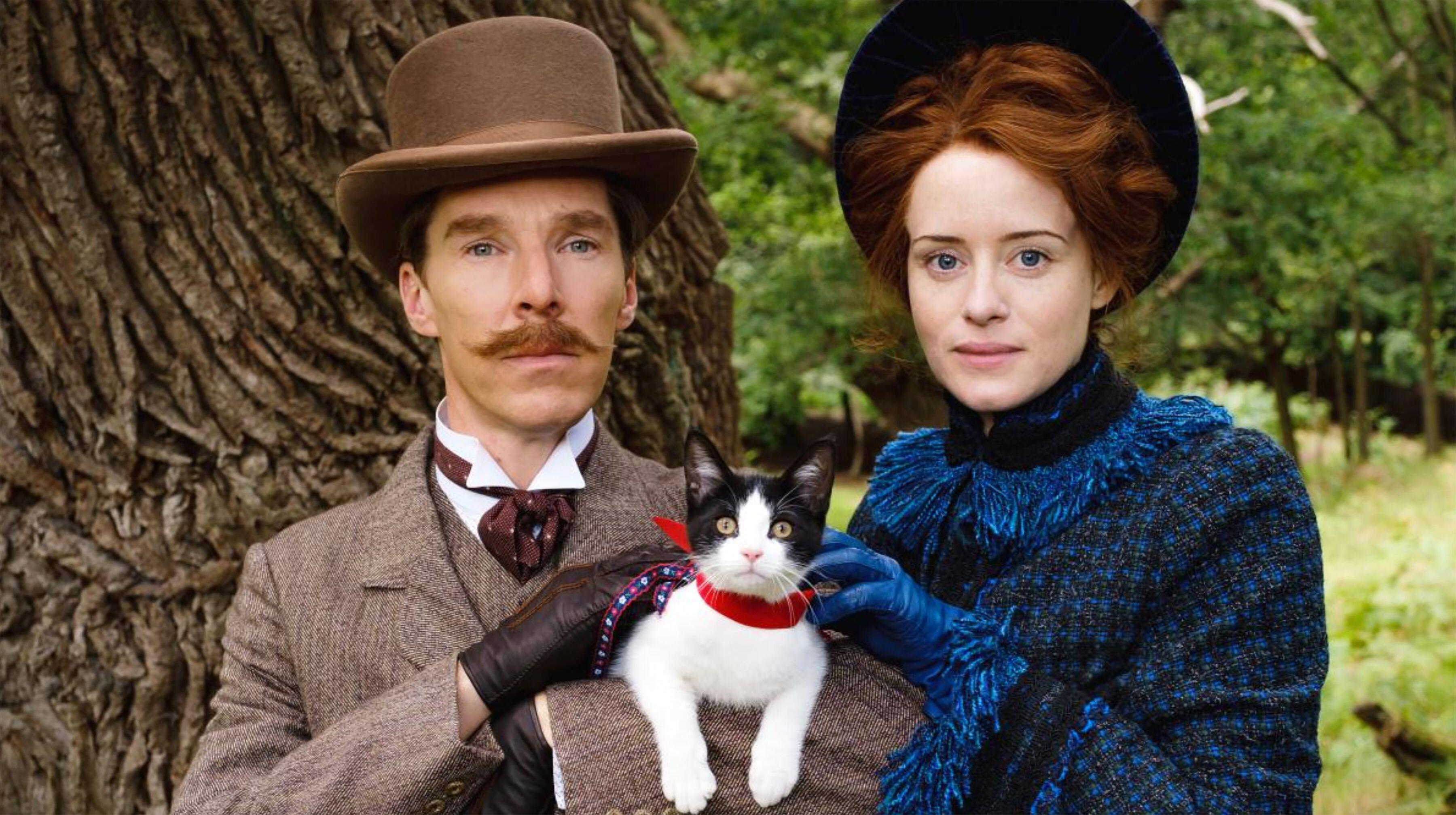
Benedict Cumberbatch as Louis Wain and Claire Foy as Emily Richardson with Peter the cat in 'The Electrical Life of Louis Wain'.
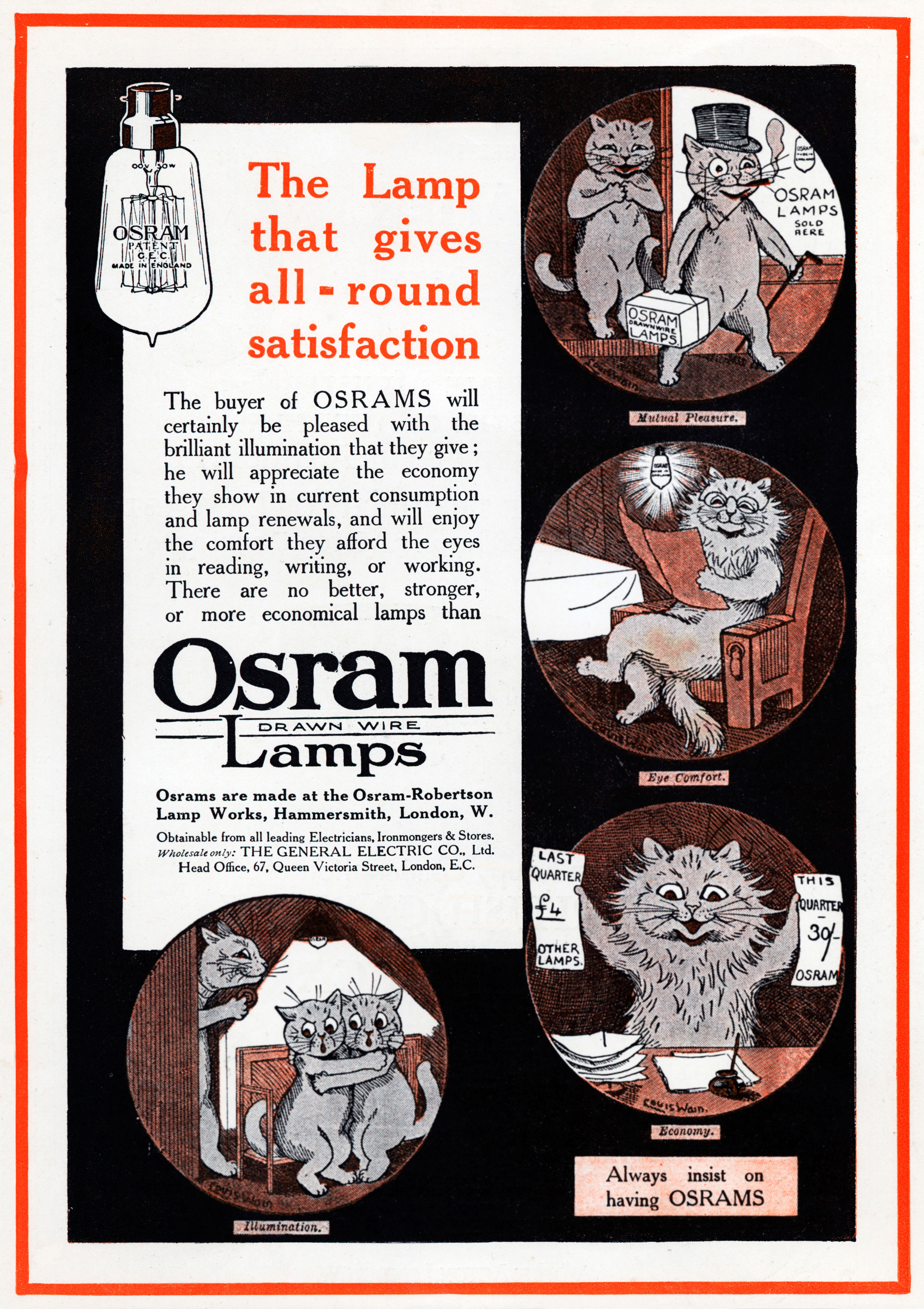
An Edwardian advert for Osram's electric lightbulbs illustrated by Louis Wain in 1909.
Sadly, he suffered a severe injury to his head in 1914 as a result of a freak accident involving a horse-drawn omnibus and was left in a coma. He was certified insane by his sisters 10 years later and admitted to Springfield Mental Hospital in Tooting. He suffered from a stroke in 1938 and died the following year, and was buried in Kensal Green — having spent the final 15 years of his life in various mental institutes, where he had continued to create art to support his family. Many of his later paintings have psychedelic qualities, later suggested by some to be indicators that he suffered from schizophrenia.
‘It’s a great story — his life and impact on Edwardian society — and it's also a sad story, due to his lapse into psychotic illness and incarceration.' Chris says. H. G. Wells once said of Wain: ‘He has made the cat his own. He invented a cat style, a cat society, a whole cat world. English cats that do not look and live like Louis Wain cats are ashamed of themselves.’
For an artist of such celebrity, his works are still very affordable, with pieces available from the Chris Beetles Gallery from £1,750. This is for two reasons, says Leo Webster, a picture specialist at Bonhams, the auction house responsible for selling much of Wain’s work. ‘He was really prolific and naturally that does tend to slow or soften the market for artists as there’s no shortage of their work,’ Leo says. ‘With Wain, if you miss out on a piece, another one is probably going to come around in a month or so.’
‘Also, it’s only more recently that people have begun taking them more seriously, certainly from an auction perspective we’ve definitely seen an uptake in demand since the film,’ he added, saying Wain’s piece’s ‘whimsical’ quality may have lowered their value in the past.
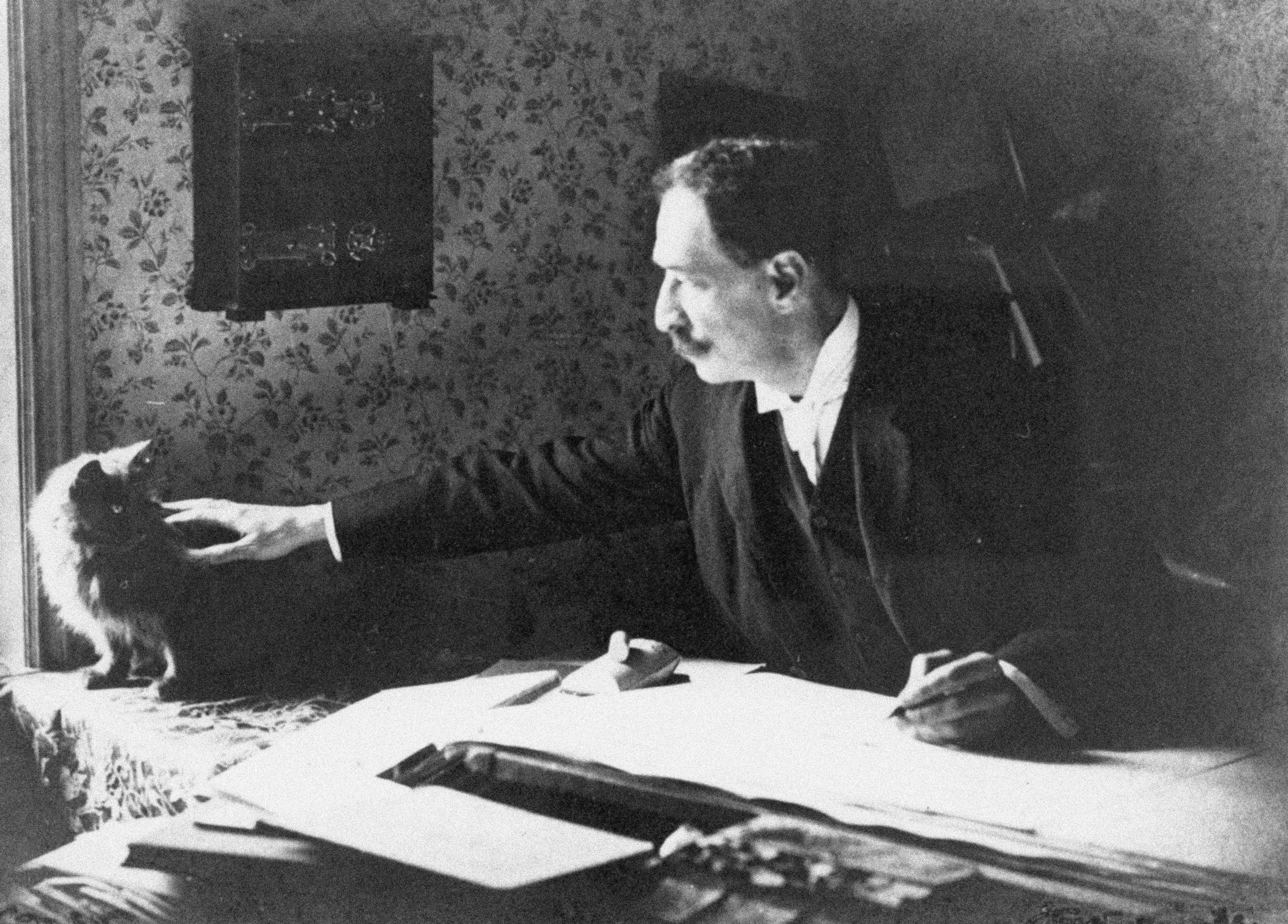
Louis Wain at his drawing board in the 1890s. The demand for his work hasn't waned since.

Louis Wain's 'Drawing Cat' shows his fascination with vivid hues that was characteristic of much of his later work.
The most famous cats of all time
- The Cat in the Hat — written and illustrated by Dr. Seuss
- Garfield — from the comic strip created by Jim Davis
- The Old Gumbie Cat, The Rum Tum Tugger, Mr. Mistoffelees et al. — all from ‘Old Possum’s Book of Practical Cats’ by T.S Eliot (their legacy since ruined by James Corden and Taylor Swift in the 2019 film reboot of the musical Cats)
- Puss in Boots — whose origins lie in a European fairytale
- The Aristocats, including O'Malley the Alley Cat — from the 1970 Disney film
- A Streetcat Named Bob — from the memoir of the same name written
- The Cheshire Cat — from Lewis Carroll’s Alice in Wonderland
- Tom — the other part to Jerry
- Cat — from Breakfast at Tiffany’s, played in the film by the feline actor Orangey
- Larry the cat — of 10, Downing Street
- Mrs Norris — Mr Filch, the caretaker’s, cat, also in the ‘Harry Potter’ books
- Foss — Edward Lear’s cat who was perhaps inspired The Owl and the Pussy-cat
- Schrödinger's cat — whose fate is unknown
- Hello Kitty — created by Yuko Shimizu and designed by Yuko Yamaguchi
- Behemoth — from the novel, The Master and Margarita, by Bulgakov
- Felix the Cat — the cartoon created in 1919 by Otto Messmer and Pat Sullivan
- Mog — who I almost forgot to include on this list, illustrated by Judith Kerr
- Fritz the Cat — who is described as ‘X-rated and animated!’
- Tom Kitten — created by Beatrix Potter,
- Choupette — Karl Lagerfeld’s famous pet
- Bagpuss — created by Peter Firmin and Oliver Postgate
‘There’s definitely more money in dog paintings than there is in cat pictures,’ Leo added, on the age-old rivalry that extends to the art market. ‘But that's definitely because there are far more dog pictures out there than there are of cats.’
One woman righting this frankly biased injustice, a brushstroke at a time, is Lesley Fotherby, who has a black cat named Pippin and is one of the artists who will be exhibited alongside Wain in The Cat Show.
‘There are so many different people there who look at cats in different ways’ she said of what she enjoys about the exhibition. It is Wain's individualism, she thinks, that sets him apart. ‘He paints cats like nobody else, so I suppose people like the quirkiness, the fact that he has a very interesting backstory and that his works are just very different.’
The joy of painting cats for Lesley is the way they move (she also paints dancers and horses for this very reason). ‘It's always a challenge to paint something that's not always going to be still in front of you,’ she says, hinting that she has fallen victim to the feline tendency to take one unawares, both with tooth and claw, during an otherwise innocent bellyrub.
So what is the creature's enduring appeal? And why do we, scratched, bloody and knowing no dog-like loyalty awaits us, continue to be pleased and delighted by the intricacies of the feline species?
‘Two reasons,’ my colleague, James Fisher, renowned in the office as the owner of a Maine Coon/Birman cross called Ted, says.
‘First, because they are at once adorably cute and ridiculous, yet somehow at the same time nature's most perfect killing machines. Second, because they do not award unconditional love. Sometimes they like you, sometimes they don't. In a world of constant and instant gratification, they are a reminder that the very good things in life need to be earned.’
‘Louis Wain & the Cat Show’ is available to view at the Chris Beetles Gallery from August 9-23
Lotte is Country Life's digital writer. Before joining in 2025, she was checking commas and writing news headlines for The Times and The Sunday Times as a sub-editor. She has written for The Times, New Statesman, The Fence and Spectator World. She pens Country Life Online's arts and culture interview series, Consuming Passions.
-
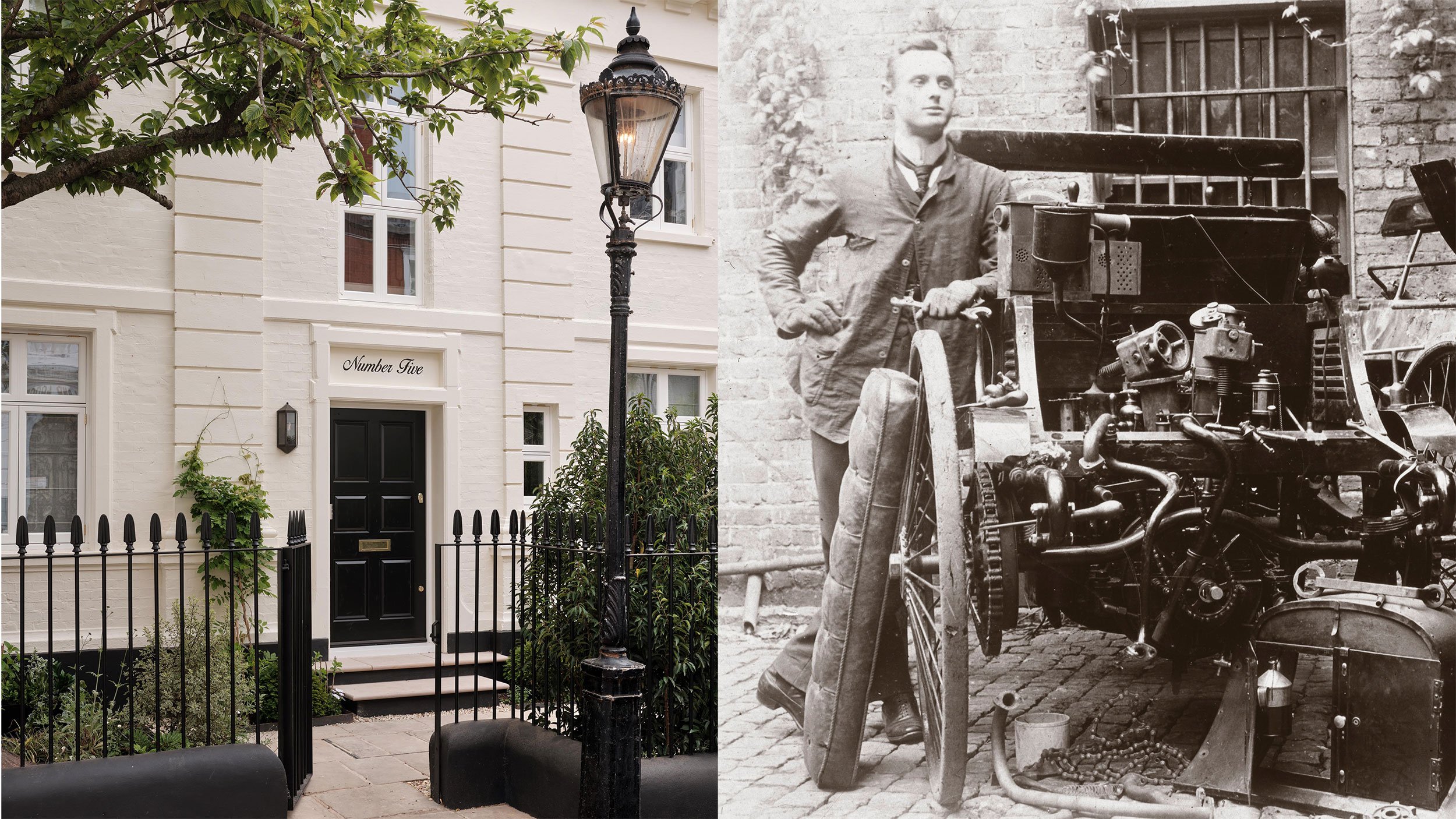 The London house where Rolls-Royce's co-founder Charles Rolls tinkered with his very first car is for sale at £17 million
The London house where Rolls-Royce's co-founder Charles Rolls tinkered with his very first car is for sale at £17 millionCharles Rolls, the engineer and co-founder of Rolls-Royce, got his hands dirty when using the stables of this fine London home as a makeshift garage. Annabel Dixon reports.
-
 The sparkling history of the match and why its inventor never got the credit he deserved
The sparkling history of the match and why its inventor never got the credit he deservedWe’ve been using matches for 200 years–but, as Rob Crossan discovers, the story of how they came to be is far more colourful (and hair-raising) than we might imagine.
-
 'Love, desire, faith, passion, intimacy, God, spiritual consciousness, curiosity and adventure': The world of Stanley Spencer, a very English visionary
'Love, desire, faith, passion, intimacy, God, spiritual consciousness, curiosity and adventure': The world of Stanley Spencer, a very English visionaryStanley Spencer’s talent for seeing the spiritual in the everyday, his stirring sense for the wonder of Nature and his love for the landscapes of Berkshire and Suffolk shaped his art, as Matthew Dennison reveals.
-
 The tourbillon watch is a masterpiece of order born out of tumult and disarray
The tourbillon watch is a masterpiece of order born out of tumult and disarrayWhat is it that makes the tourbillon — one the most beguiling instruments in watchmaking — tick?
-
 What a report on the spending of female billionaires tells us about the future of museum collections
What a report on the spending of female billionaires tells us about the future of museum collectionsBetween 2015 and 2024, the number of female billionaires grew from 190 to 344. Could this be good news for the art world?
-
 Items from the collection of Lady Glenconner are going under the hammer, including a nine-carat gold Cartier box gifted to her by Elizabeth II
Items from the collection of Lady Glenconner are going under the hammer, including a nine-carat gold Cartier box gifted to her by Elizabeth II‘I have had such great pleasure living with these wonderful objects, each telling their own fascinating story.’
-
 What do women want (on wheels)?
What do women want (on wheels)?James Fisher gets to drive fast cars for a living, but are sleek lines and high horsepower quite the 'babe magnets' so many men think they are? On a quest to find the truth, he dared do the unthinkable.... which was to just ask them.
-
 Cheaper to steal than to buy: Napoleon's brooch sells for £4.4 million – 17 times its estimate
Cheaper to steal than to buy: Napoleon's brooch sells for £4.4 million – 17 times its estimateNapoleon's one-of-a-kind brooch went under the hammer and vastly outstripped its pre-sale estimate.
-
 Savile Row might be the beating heart of bespoke men's tailoring, but it was named after a woman
Savile Row might be the beating heart of bespoke men's tailoring, but it was named after a womanSavile Row is the home of the bespoke suit, but its history is a lot more colourful than you might expect.
-
 A painting owned by Edward Guinness is on display next to a near identical version at Kenwood House — but which one is the real Vermeer?
A painting owned by Edward Guinness is on display next to a near identical version at Kenwood House — but which one is the real Vermeer?A mini exhibition at Kenwood House allows viewers to ‘to practise their own connoisseurship’.
